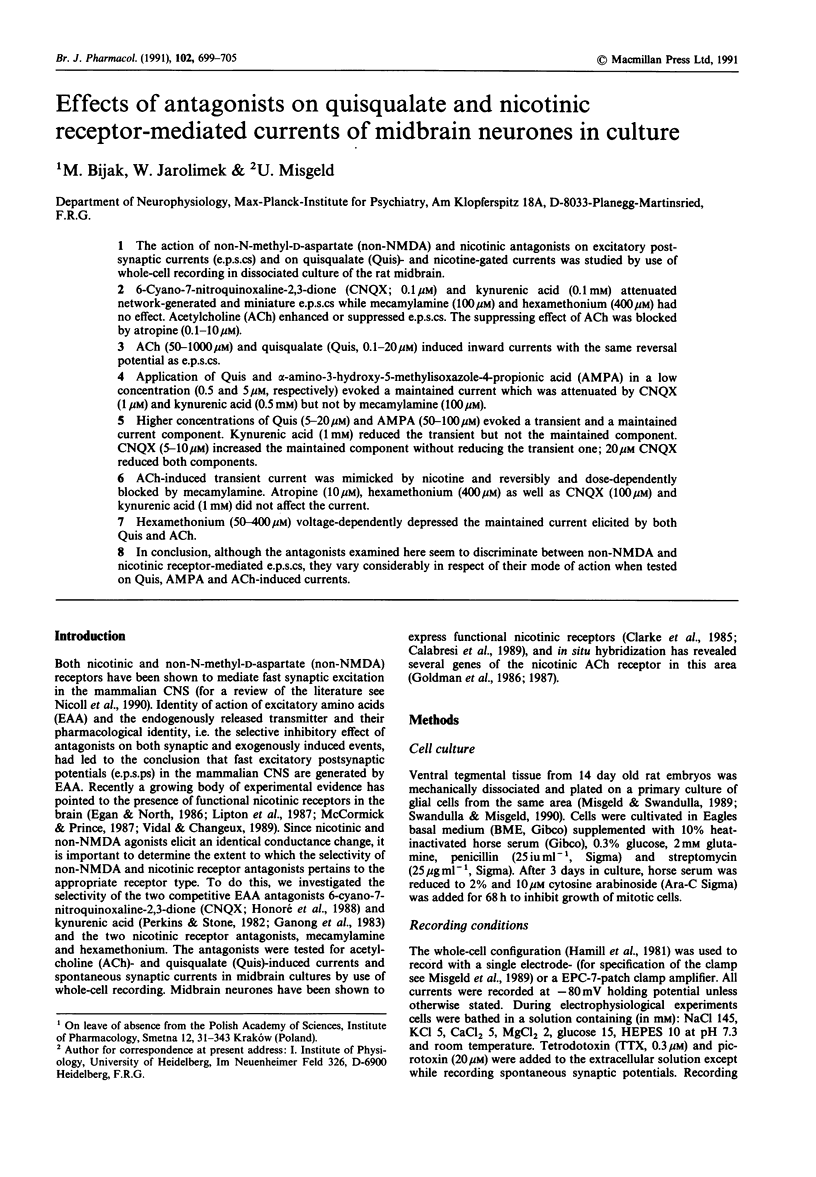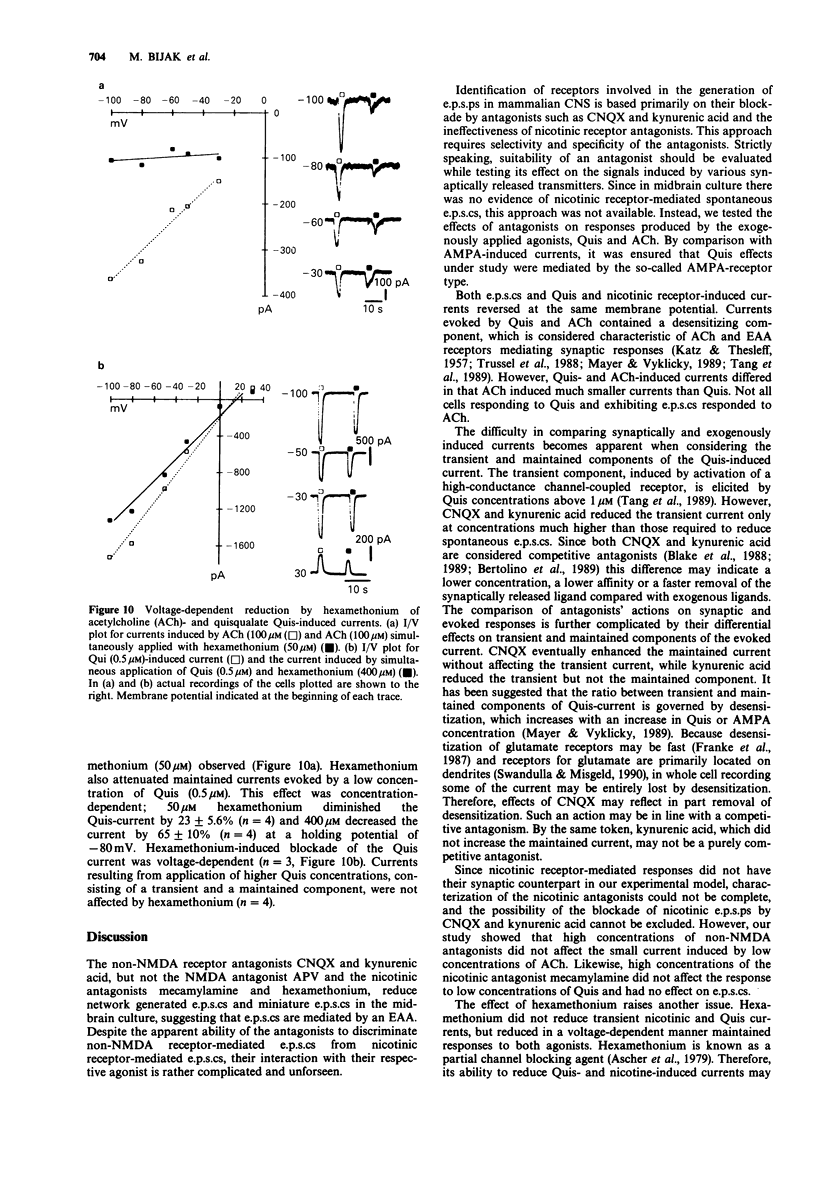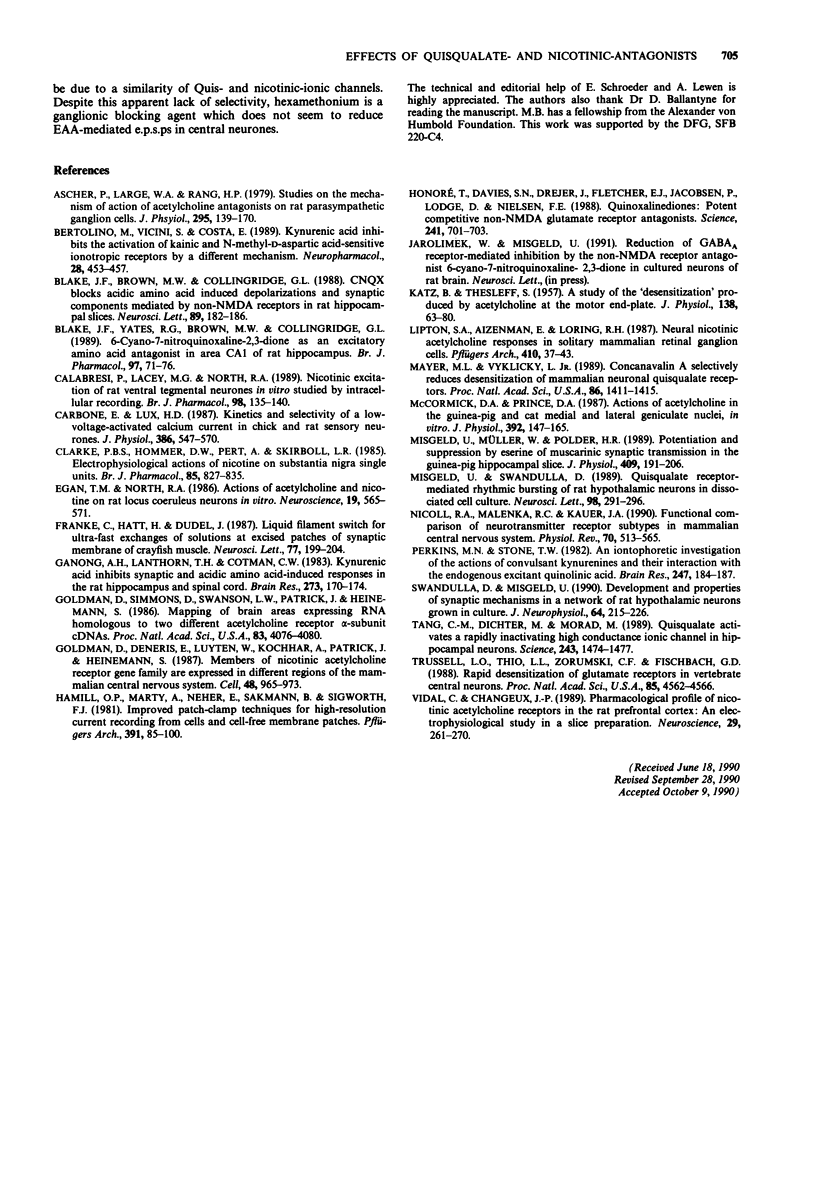Abstract
1. The action of non-N-methyl-D-aspartate (non-NMDA) and nicotinic antagonists on excitatory postsynaptic currents (e.p.s.cs) and on quisqualate (Quis)- and nicotine-gated currents was studied by use of whole-cell recording in dissociated culture of the rat midbrain. 2. 6-Cyano-7-nitroquinoxaline-2,3-dione (CNQX; 0.1 microM) and kynurenic acid (0.1 mM) attenuated network-generated and miniature e.p.s.cs while mecamylamine (100 microM) and hexamethonium (400 microM) had no effect. Acetylcholine (ACh) enhanced or suppressed e.p.s.cs. The suppressing effect of ACh was blocked by atropine (0.1-10 microM). 3. ACh (50-1000 microM) and quisqualate (Quis, 0.1-20 microM) induced inward currents with the same reversal potential as e.p.s.cs. 4. Application of Quis and alpha-amino-3-hydroxy-5-methylisoxazole-4-propionic acid (AMPA) in a low concentration (0.5 and 5 microM, respectively) evoked a maintained current which was attenuated by CNQX (1 microM) and kynurenic acid (0.5 mM) but not by mecamylamine (100 microM). 5. Higher concentrations of Quis (5-20 microM) and AMPA (50-100 microM) evoked a transient and a maintained current component. Kynurenic acid (1 mM) reduced the transient but not the maintained component. CNQX (5-10 microM) increased the maintained component without reducing the transient one; 20 microM CNQX reduced both components. 6. ACh-induced transient current was mimicked by nicotine and reversibly and dose-dependently blocked by mecamylamine. Atropine (10 microM), hexamethonium (400 microM) as well as CNQX (100 microM) and kynurenic acid (1 mM) did not affect the current.(ABSTRACT TRUNCATED AT 250 WORDS)
Full text
PDF






Selected References
These references are in PubMed. This may not be the complete list of references from this article.
- Ascher P., Large W. A., Rang H. P. Studies on the mechanism of action of acetylcholine antagonists on rat parasympathetic ganglion cells. J Physiol. 1979 Oct;295:139–170. doi: 10.1113/jphysiol.1979.sp012958. [DOI] [PMC free article] [PubMed] [Google Scholar]
- Bertolino M., Vicini S., Costa E. Kynurenic acid inhibits the activation of kainic and N-methyl-D-aspartic acid-sensitive ionotropic receptors by a different mechanism. Neuropharmacology. 1989 May;28(5):453–457. doi: 10.1016/0028-3908(89)90078-6. [DOI] [PubMed] [Google Scholar]
- Blake J. F., Brown M. W., Collingridge G. L. CNQX blocks acidic amino acid induced depolarizations and synaptic components mediated by non-NMDA receptors in rat hippocampal slices. Neurosci Lett. 1988 Jun 29;89(2):182–186. doi: 10.1016/0304-3940(88)90378-3. [DOI] [PubMed] [Google Scholar]
- Blake J. F., Yates R. G., Brown M. W., Collingridge G. L. 6-Cyano-7-nitroquinoxaline-2,3-dione as an excitatory amino acid antagonist in area CA1 of rat hippocampus. Br J Pharmacol. 1989 May;97(1):71–76. doi: 10.1111/j.1476-5381.1989.tb11925.x. [DOI] [PMC free article] [PubMed] [Google Scholar]
- Calabresi P., Lacey M. G., North R. A. Nicotinic excitation of rat ventral tegmental neurones in vitro studied by intracellular recording. Br J Pharmacol. 1989 Sep;98(1):135–140. doi: 10.1111/j.1476-5381.1989.tb16873.x. [DOI] [PMC free article] [PubMed] [Google Scholar]
- Carbone E., Lux H. D. Kinetics and selectivity of a low-voltage-activated calcium current in chick and rat sensory neurones. J Physiol. 1987 May;386:547–570. doi: 10.1113/jphysiol.1987.sp016551. [DOI] [PMC free article] [PubMed] [Google Scholar]
- Clarke P. B., Hommer D. W., Pert A., Skirboll L. R. Electrophysiological actions of nicotine on substantia nigra single units. Br J Pharmacol. 1985 Aug;85(4):827–835. doi: 10.1111/j.1476-5381.1985.tb11081.x. [DOI] [PMC free article] [PubMed] [Google Scholar]
- Egan T. M., North R. A. Actions of acetylcholine and nicotine on rat locus coeruleus neurons in vitro. Neuroscience. 1986 Oct;19(2):565–571. doi: 10.1016/0306-4522(86)90281-2. [DOI] [PubMed] [Google Scholar]
- Franke C., Hatt H., Dudel J. Liquid filament switch for ultra-fast exchanges of solutions at excised patches of synaptic membrane of crayfish muscle. Neurosci Lett. 1987 Jun 15;77(2):199–204. doi: 10.1016/0304-3940(87)90586-6. [DOI] [PubMed] [Google Scholar]
- Ganong A. H., Lanthorn T. H., Cotman C. W. Kynurenic acid inhibits synaptic and acidic amino acid-induced responses in the rat hippocampus and spinal cord. Brain Res. 1983 Aug 22;273(1):170–174. doi: 10.1016/0006-8993(83)91108-3. [DOI] [PubMed] [Google Scholar]
- Goldman D., Deneris E., Luyten W., Kochhar A., Patrick J., Heinemann S. Members of a nicotinic acetylcholine receptor gene family are expressed in different regions of the mammalian central nervous system. Cell. 1987 Mar 27;48(6):965–973. doi: 10.1016/0092-8674(87)90705-7. [DOI] [PubMed] [Google Scholar]
- Hamill O. P., Marty A., Neher E., Sakmann B., Sigworth F. J. Improved patch-clamp techniques for high-resolution current recording from cells and cell-free membrane patches. Pflugers Arch. 1981 Aug;391(2):85–100. doi: 10.1007/BF00656997. [DOI] [PubMed] [Google Scholar]
- Honoré T., Davies S. N., Drejer J., Fletcher E. J., Jacobsen P., Lodge D., Nielsen F. E. Quinoxalinediones: potent competitive non-NMDA glutamate receptor antagonists. Science. 1988 Aug 5;241(4866):701–703. doi: 10.1126/science.2899909. [DOI] [PubMed] [Google Scholar]
- KATZ B., THESLEFF S. A study of the desensitization produced by acetylcholine at the motor end-plate. J Physiol. 1957 Aug 29;138(1):63–80. doi: 10.1113/jphysiol.1957.sp005838. [DOI] [PMC free article] [PubMed] [Google Scholar]
- Lipton S. A., Aizenman E., Loring R. H. Neural nicotinic acetylcholine responses in solitary mammalian retinal ganglion cells. Pflugers Arch. 1987 Sep;410(1-2):37–43. doi: 10.1007/BF00581893. [DOI] [PubMed] [Google Scholar]
- Mayer M. L., Vyklicky L., Jr Concanavalin A selectively reduces desensitization of mammalian neuronal quisqualate receptors. Proc Natl Acad Sci U S A. 1989 Feb;86(4):1411–1415. doi: 10.1073/pnas.86.4.1411. [DOI] [PMC free article] [PubMed] [Google Scholar]
- McCormick D. A., Prince D. A. Actions of acetylcholine in the guinea-pig and cat medial and lateral geniculate nuclei, in vitro. J Physiol. 1987 Nov;392:147–165. doi: 10.1113/jphysiol.1987.sp016774. [DOI] [PMC free article] [PubMed] [Google Scholar]
- Misgeld U., Müller W., Polder H. R. Potentiation and suppression by eserine of muscarinic synaptic transmission in the guinea-pig hippocampal slice. J Physiol. 1989 Feb;409:191–206. doi: 10.1113/jphysiol.1989.sp017492. [DOI] [PMC free article] [PubMed] [Google Scholar]
- Misgeld U., Swandulla D. Quisqualate receptor-mediated rhythmic bursting of rat hypothalamic neurons in dissociated cell culture. Neurosci Lett. 1989 Apr 10;98(3):291–296. doi: 10.1016/0304-3940(89)90416-3. [DOI] [PubMed] [Google Scholar]
- Nicoll R. A., Malenka R. C., Kauer J. A. Functional comparison of neurotransmitter receptor subtypes in mammalian central nervous system. Physiol Rev. 1990 Apr;70(2):513–565. doi: 10.1152/physrev.1990.70.2.513. [DOI] [PubMed] [Google Scholar]
- Perkins M. N., Stone T. W. An iontophoretic investigation of the actions of convulsant kynurenines and their interaction with the endogenous excitant quinolinic acid. Brain Res. 1982 Sep 9;247(1):184–187. doi: 10.1016/0006-8993(82)91048-4. [DOI] [PubMed] [Google Scholar]
- Tang C. M., Dichter M., Morad M. Quisqualate activates a rapidly inactivating high conductance ionic channel in hippocampal neurons. Science. 1989 Mar 17;243(4897):1474–1477. doi: 10.1126/science.2467378. [DOI] [PubMed] [Google Scholar]
- Trussell L. O., Thio L. L., Zorumski C. F., Fischbach G. D. Rapid desensitization of glutamate receptors in vertebrate central neurons. Proc Natl Acad Sci U S A. 1988 Jun;85(12):4562–4566. doi: 10.1073/pnas.85.12.4562-a. [DOI] [PMC free article] [PubMed] [Google Scholar]
- Vidal C., Changeux J. P. Pharmacological profile of nicotinic acetylcholine receptors in the rat prefrontal cortex: an electrophysiological study in a slice preparation. Neuroscience. 1989;29(2):261–270. doi: 10.1016/0306-4522(89)90056-0. [DOI] [PubMed] [Google Scholar]


